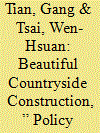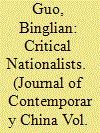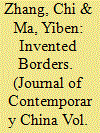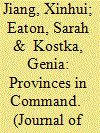|
|
|
Sort Order |
|
|
|
Items / Page
|
|
|
|
|
|
|
| Srl | Item |
| 1 |
ID:
192131


|
|
|
|
|
| Summary/Abstract |
This article seeks to demonstrate that there is a certain degree of political participation in contemporary China. We argue that the qunzhong, or ‘masses’, in China can be divided into three categories: members of autonomous grassroots organizations, local elites (xin xiangxian), and victims of rights violations, and we illustrate our discussion of the impact of these three groups on policy through the example of the ‘Beautiful Countryside Construction’ policy. Our analysis focuses on how the masses express their opinions to inspection teams dispatched by county governments. Finally, we argue that China’s grassroots qunzhong do have a role in providing feedback on policy, but whether their suggestions are heeded by the higher-level authorities still depends on wider political considerations.
|
|
|
|
|
|
|
|
|
|
|
|
|
|
|
|
| 2 |
ID:
192135


|
|
|
|
|
| Summary/Abstract |
Punishment from the state can rely on formal state apparatuses, but also the mobilization and co-option of the deviant’s own social connections to enhance the power of social control. This study utilizes a mixed-method design based on 30 interviews and a national survey to examine how such ‘relational punishment’ operates in China today as part of the nation-wide Social Credit Blacklist System. The authors first trace the history of blacklisting as a governance tool. The article then illustrates how the state’s symbolic campaign encourages the ostracization of blacklisted people. However, this power has its limits. People commonly differentiate the character of blacklisted people with contextual and relational information, constructing alternative meanings for individuals thus labelled, therefore undermining the reach and influence of the Blacklist System.
|
|
|
|
|
|
|
|
|
|
|
|
|
|
|
|
| 3 |
ID:
192129


|
|
|
|
|
| Summary/Abstract |
This study systematically examines, deconstructs, and maps the quotidian nationalist discourse among Chinese netizens and analyzes their ‘liking’ behavior on the social media platform, Zhihu, in order to investigate what and how they talk about nationalism. The analysis of the quotidian expression of nationalism marks a shift from the previous practice of relying on high-profile nationalist movements as evidence which may create an incomplete or inaccurate impression that much of Chinese nationalism is virulent and over-zealous. This study finds that Zhihu users are critical nationalists who are competitive but judicious. The existence of levelheaded nationalists in China’s online space suggests the limits of strident nationalist contagion and nationalist mobilization.
|
|
|
|
|
|
|
|
|
|
|
|
|
|
|
|
| 4 |
ID:
192136


|
|
|
|
|
| Summary/Abstract |
This study revisits the question of whether China's economic development has brought democratic changes within the country or not. While the modernization theory suggests that economic development should lead to democratization, scholars claim that China has not made democratic progress despite its economic growth. By comparing these two competing perspectives and examining the evidence behind each assessment, I argue that there has been a certain degree of democratic progress in China, in terms of increasing social aspirations for a more open and free society among the Chinese people. I explain why and how scholars reach different conclusions about democratic progress in China, and emphasize the importance of understanding discrepancies between (1) the lack of change in the state’s system, (2) oscillation between liberal and illiberal policies, and (3) progressive changes in society. This article draws on previous studies and data from the World Value System, Varieties of Democracy, and Asian Barometer projects. It also discusses how Chinese people's local understanding of democracy affects the assessment of modernization theory's applicability in explaining China's case.
|
|
|
|
|
|
|
|
|
|
|
|
|
|
|
|
| 5 |
ID:
192134


|
|
|
|
|
| Summary/Abstract |
Contrary to the arguments in most of the literature, the central government of China applies diversified rather than homogenous measures to govern its Ethnic Tibetan Autonomous Areas (ETAA). Applying the analytical framework of ‘inner and outer peripheries’, this research argues that the central government has favoured the Tibetan Autonomous Region (TAR), particularly in state fiscal assistance, over the other ETAAs, due to its unique governance challenge. This research analyses the central government’s fiscal assistance to the ETAAs from 2010 to 2019 and reveals an increasing fiscal gap between them. Not only has the TAR been consistently in the lead but fiscal inequality has also grown among ETAAs in the provinces of Sichuan, Yunnan, Qinghai and Gansu. Fieldwork in the TAR, Yunnan, Gansu and Sichuan reveals that the fiscal gap, combined with varied local circumstances, has created multifaceted social and economic unevenness in the ETAAs.
|
|
|
|
|
|
|
|
|
|
|
|
|
|
|
|
| 6 |
ID:
192127


|
|
|
|
|
| Summary/Abstract |
Popular nationalism increasingly dominates public debate in mainland China. This article examines the impact of this trend on Chinese policymaking by looking at the public consultation procedure for new regulations on foreigners’ permanent residency in February 2020. Following an unexpectedly large online outcry of anti-immigrant sentiment in response to the draft regulations, government actors shelved the proposal, which constituted a long-delayed step towards a more comprehensive immigration framework. Drawing on textual analysis, expert interviews, and survey data, the article analyzes elite-public interactions before, during, and after the controversy, asking what factors contributed to this miscalculation of public sentiment, and what the P.R. debate can tell us about the role of public opinion in Chinese policymaking today. It argues that popular nationalists can play a bottom-up politicizing role on previously marginal policy issues such as immigration, surprising and constraining the state. Such politicisation further limits both public and elite policy debate, impairing state information gathering and exacerbating the tension between Chinese policy actors’ desire to both control and understand public sentiment. In addition, the permanent residency debate demonstrates the relevance of public opinion to China’s non-democratic immigration policymaking, which displays a trajectory of gradual politicisation similar to other early-stage immigrant-reception contexts.
|
|
|
|
|
|
|
|
|
|
|
|
|
|
|
|
| 7 |
ID:
192128


|
|
|
|
|
| Summary/Abstract |
Patriotic campaigns and mass mobilization draw on existing xenophobic attitudes of the public, reinforcing the ‘us vs. them’ dualism between China and ‘the West’. However, patriotic campaigns are not always top-down, state-led, nor are they always primarily driven by political ideology. Patriotic content appeals to a growing nationalist audience who consumes a mixed feeling of perceived victimization at the hand of foreign aggression and the pride arising from being a Chinese citizen. This paper argues that the profitability of patriotic content circulating on social media exacerbated the tension between market-driven grassroots patriotism and state-led patriotic campaigns. The tension grows out of, and is manifested in, the online popular debate around economically driven, grassroots ‘patriotic’ content that can challenge the state state-led patriotic rhetoric. While the state sometimes strategically co-opts some patriotic contents into its own patriotic narratives, it also delegitimises other undesired ones through labels such as ‘high-level black’ (gaoji hei) or ‘low-level red’ (diji hong). These labels were initially used to differentiate meticulously crafted political satire and parody from incompetent, illogical and vulgar propaganda pieces that unintendedly blemish the state’s patriotic campaigns, but later evolved into an exercise of power to distance the CCP from undesired patriotic content.
|
|
|
|
|
|
|
|
|
|
|
|
|
|
|
|
| 8 |
ID:
192133


|
|
|
|
|
| Summary/Abstract |
Since late 2016, Ningxia has drawn attention as a new target in Beijing’s drive to ‘Sinicize Islam.’ The removal of overt signs of the Islamic faith and Arab influences is viewed as representing a new front in the CCP’s sweeping rollback of religious freedom. Is Ningxia another Xinjiang as both the party and its critics fear? This paper argues that it is not at the empirical level but shares with Xinjiang key underlying dynamics at the systemic level. At the empirical level, Ningxia’s ‘Islamization’ stemmed largely from local authorities’ use of the Islamic part of Ningxia’s heritage as a developmental strategy, leading to so-called pan-Halalfication, Saudization and Arabization. In contrast to more complex social dynamics in Xinjiang, Ningxia’s ‘Islamization’ can be more easily dealt with by withdrawing the local state’s own promotion. At the systemic level, the rise and fall of Islamization in Ningxia share with Xinjiang’s case the critical role of the state in affecting the fate of religion for significant ethno-religious communities.
|
|
|
|
|
|
|
|
|
|
|
|
|
|
|
|
| 9 |
ID:
192130


|
|
|
|
|
| Summary/Abstract |
County-to-district mergers (chexian gaiqu), a major form of ’administrative division adjustment’ (ADA), have occurred with striking frequency across Chinese cities in recent decades. Despite the high stakes of county mergers, scholars have yet to systematically analyze the political variables that shape where and when such reforms occur. Addressing this gap, the authors assemble a novel dataset to examine the relationship between institutional and leadership factors at different government levels and the incidence of county mergers. This analysis highlights the importance of national leadership priorities in shaping the frequency and regional distribution of county mergers. It also finds that, at least in times of greater central policy permissiveness, the bargaining power of cities is a strong predictor of which localities carry out county mergers.
|
|
|
|
|
|
|
|
|
|
|
|
|
|
|
|
| 10 |
ID:
192132


|
|
|
|
|
| Summary/Abstract |
China’s ‘Xi-Li era’ is said to be defined by both the concentration of power in the center and the strengthening of Party authority. In this paper, we ask whether these trends have been evident in local appointment practices since Xi Jinping took office in 2013. By comparing the career histories of 3,682 prefectural mayors and Party Secretaries under the Hu-Wen and Xi-Li administrations, we find that while appointment practices have shifted, the observed changes are not wholly consistent with the center- and Party-strengthening narratives. First, developments in the Xi-Li era suggest that while provincial authorities are increasingly using prefectural appointments for their own ends, the center remains high and far away in these decisions. Second, we do not find evidence that cadres with a strong Party background have a particular advantage in the Xi period. Instead, cadres with strong track records in key functional xitong, particularly those with an economic profile, are still the most likely to attain leadership positions. These findings contribute to the current debate on the nature of power reconfigurations unfolding in Xi’s China.
|
|
|
|
|
|
|
|
|
|
|
|
|
|
|
|
|
|
|
|
|